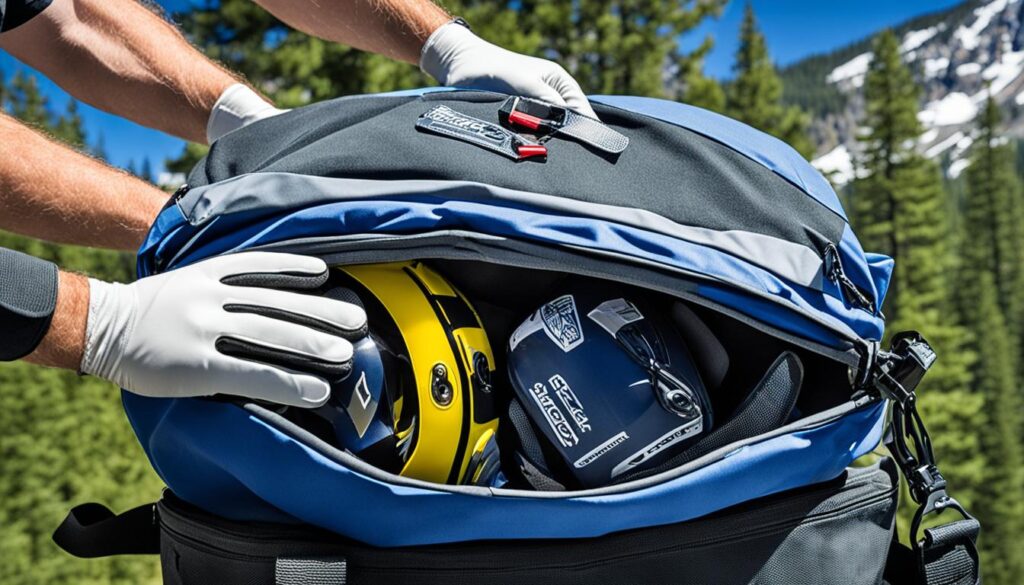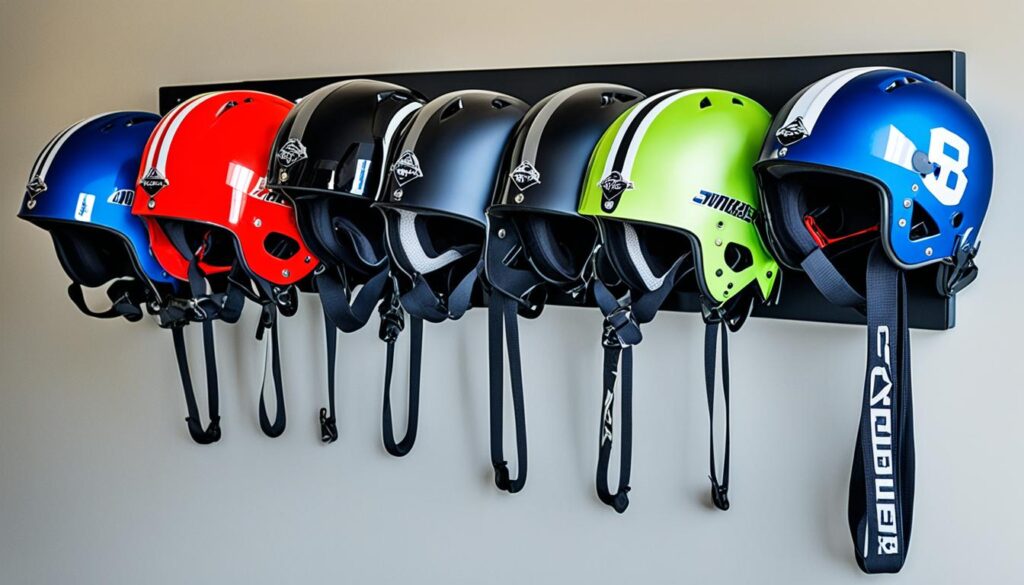
When it comes to riding motorcycles, safety is of utmost importance. And one crucial aspect of ensuring your safety on the road is the proper care and maintenance of your helmet. But how much do you really know about helmet care? Are you following the best practices? Is your helmet really providing optimal protection?
Let’s delve into the world of helmet care and maintenance and discover the essential tips that will not only keep you safe but also extend the lifespan of your helmet.
Key Takeaways:
- Regularly clean your helmet using mild soap or pure water to prevent damage to the protective coating.
- Handle your helmet gently and avoid dropping it, as even a small impact can compromise its protective capabilities.
- Use the helmet bag provided to protect it from accidental damage when not in use.
- Avoid hanging your helmet, as it can cause damage to the inner lining and increase the risk of it falling.
- Store your helmet in a cool, dry place away from direct sunlight, fuel, and cleaning fluids.
Fragile Handle with Care
Treat your helmet as if it’s fragile, as even a small drop can weaken its protective ability. Helmets are designed to disperse impact throughout their structure, and each impact or drop can compromise its effectiveness. Avoid dropping your helmet and handle it gently to ensure its longevity and performance.
When it comes to helmet care and maintenance, one of the most critical aspects is handling it with care. The structure and integrity of a helmet can be fragile, and any impact, no matter how minor, can significantly affect its protective capabilities. It’s important to recognize that helmets are engineered to disperse impact energy throughout their construction, which is why they are designed to be sturdy.
However, even a small drop can cause micro-fractures or structural damage that compromises the helmet’s ability to provide adequate protection. Each impact or drop weakens the helmet’s structure and can compromise its protective ability. To ensure your helmet remains in top condition and provides optimal protection, it’s crucial to avoid dropping it and handle it with care.
When carrying your helmet, hold it securely and avoid any sudden movements that may cause it to slip from your grasp. Keep in mind that the helmet is not just a stylish accessory but a crucial safety gear that could potentially save your life in case of an accident.
“A helmet is your first line of defense on the road. Treat it as you would a fragile item, taking the necessary precautions to maintain its integrity and protection.” – Safety Helmet Manufacturers Association
Remember, each impact weakens the helmet’s structure, making it less effective in the event of a collision. Therefore, it is essential to handle your helmet gently and avoid dropping it at all costs. By treating your helmet as a fragile item, you can preserve its protective abilities, ensuring your safety on the road.
Taking Precautions for Helmet Impact Prevention
There are several precautions you can take to prevent helmet impacts and ensure its long-term performance:
- Always handle your helmet with care: Avoid rough handling or mishandling that can cause damage to the structure or inner components of the helmet.
- Secure your helmet properly: Make sure the chin strap is securely fastened and properly adjusted to keep the helmet in place while riding.
- Avoid placing heavy objects on top of your helmet: Do not stack heavy items on or against your helmet, as this can cause significant damage that compromises its protective capabilities.
- Store your helmet in a safe location: When not in use, store your helmet in a cool, dry, and secure place to protect it from potential accidents or impacts.
Use a Helmet Bag for Protection
One of the best ways to protect your helmet from damage is by using a helmet bag. When you are not wearing your helmet, always store it in the bag that comes with it. This simple step can provide essential protection against accidental damage, such as bumps against objects or even a fall.
Carrying your helmet in a bag not only protects it from scratches but also prevents dents and other types of damage that can occur when it’s not in use. The bag acts as a cushion and barrier, keeping your helmet safe and secure.
A helmet bag is designed specifically to fit your helmet snugly, ensuring that it stays in place and doesn’t move around during transportation. This helps to maintain its shape and integrity, reducing the risk of any damage.
Whether you are commuting to work or heading out for a ride, using a helmet bag is an effective way to carry your helmet safely. It keeps your helmet protected from external elements, such as dust, debris, and moisture, which can degrade the materials and affect the helmet’s performance.
Investing in a high-quality helmet bag is a small price to pay for the added protection and peace of mind it provides. It is a wise choice to safeguard your helmet, ensuring it stays in optimal condition for a longer lifespan.
Remember, a helmet bag is more than just a convenient carrying case – it is an essential accessory that helps protect your helmet from damage, allowing you to enjoy a safe and comfortable ride every time.

Avoid Hanging Your Helmet
Hanging your helmet may seem like a convenient storage option, but it can actually lead to potential damage and compromise its integrity. Helmet hanging is a practice that should be avoided to ensure the longevity and safety of your helmet.
When you hang your helmet on your motorcycle’s mirrors or any other object, you risk damaging the inner lining. The inner lining of a helmet is designed to provide cushioning and a secure fit, and any inner lining damage can affect its effectiveness in protecting your head.
Additionally, wind gusts or accidental bumps can cause the helmet to fall, resulting in dents, scratches, or even more severe damage. To avoid these risks, it’s best to place your helmet on a flat surface or store it in a secure location. This will help maintain the structural integrity of the helmet and prevent unnecessary wear and tear.

By opting for proper helmet storage, you can ensure that your helmet remains in excellent condition when you’re not wearing it. It’s worth investing in a helmet bag or case to provide an extra layer of protection and minimize the risk of damage during storage.
Expert Tip:
Remember, a helmet is a vital safety accessory that should be cared for properly. Avoid hanging it and opt for safer storage options to avoid any potential damage that may compromise its ability to protect you on the road.
Proper Cleaning Techniques
Keeping your helmet clean is not only important for its appearance but also for its performance and longevity. To ensure your helmet remains in top condition, follow these proper cleaning techniques:
Gentle Cleaning Methods
When it comes to cleaning your helmet, using gentle methods is crucial. Avoid using regular cleaning products or harsh chemicals, as they can damage the protective coating, graphics, or materials of the helmet. Instead, opt for pure water or mild soap specifically made for cleaning helmets.
Cleaning the Exterior
To clean the exterior of your helmet, use a soft cloth or sponge. Gently wipe the surface in a circular motion, removing dirt and grime without applying excessive pressure. This gentle approach helps preserve the integrity of the helmet’s materials and finishes.
Removing Bugs from the Visor
One common challenge when riding is dealing with bugs on the visor. To remove bugs effectively, place a wet towel or tissue paper on the visor for a few minutes. The moisture will make it easier to wipe away the bugs without scratching the surface. Afterward, use a soft cloth or sponge to clean the visor with mild, non-abrasive cleaner designed for helmet visors.
“Regular cleaning products or harsh chemicals can damage the protective coating, graphics, or materials of the helmet.”
By following these proper cleaning techniques, you can maintain the integrity and functionality of your helmet for years to come. Remember to always use gentle cleaning methods, avoid harsh chemicals, and take extra care when cleaning the visor to protect your investment and ensure optimal safety on the road.
Protecting the Visor
The visor is an important part of the helmet that protects your eyes and provides visibility. Keeping the visor clean and in good condition is crucial for a safe and comfortable ride. Here are some essential tips for visor care:
Visor Cleaning
- Use a soft cloth or sponge to clean the visor.
- Choose a mild, non-abrasive cleaner specifically designed for helmet visors.
- Avoid using glass cleaners or ammonia-based products, as they can damage the anti-fog and scratch-resistant coatings on the visor.
- Gently wipe the visor in a circular motion, removing any dirt, bugs, or debris.
- Rinse the visor thoroughly with clean water to ensure all residue is removed.
- Air dry the visor or use a lint-free cloth to gently dry it.
Anti-Fog Coatings
“The anti-fog coating on the visor is a valuable feature as it prevents fogging, ensuring clear vision while riding.” – Dr. Sarah Thompson, Helmet Safety Expert
When cleaning the visor, be sure to avoid any abrasive actions that may scratch or damage the anti-fog coating. It’s also important to note that excessive wiping or using rough materials can deteriorate the coating over time. Take care to follow the manufacturer’s recommendations for cleaning and maintenance.
Additionally, consider investing in a helmet with a high-quality anti-fog visor that provides lasting protection against fogging. These visors are treated with advanced coatings designed to minimize fogging and ensure optimal visibility in various weather conditions.
By following these visor care tips, you can maintain a clear and unobstructed view while riding, enhancing your safety on the road.
Storing Your Helmet Properly
Proper helmet storage is essential for ensuring its protection and avoiding damage during storage. Here are some important tips to keep in mind:
- Avoid storing your helmet near fuel, cleaning fluids, excessive heat, or direct sunlight. Exposure to these elements can damage the materials used in the helmet’s construction and compromise its integrity.
- Consider using a dedicated helmet bag or case to protect your helmet from scratches and impacts during storage. The bag should provide proper cushioning and should be designed specifically for storing helmets.
- Remember not to store your gloves inside the helmet. Gloves may contain substances like oils and solvents that can damage the interior lining over time. Keep your helmet clean and free from any potential contaminants.
By following these proper helmet storage practices, you can ensure that your helmet remains in excellent condition, ready to provide optimal protection whenever you need it.
Regular Helmet Replacement
Ensuring the safety and effectiveness of your motorcycle helmet requires regular replacement. Most reputable helmet manufacturers recommend replacing your helmet every five years, regardless of visible damage. This proactive approach to helmet replacement accounts for the natural deterioration that occurs over time due to various factors.
Exposure to UV rays, sweat, and other environmental elements can cause the materials in your helmet to degrade, compromising its protective capabilities. The integrity of the helmet’s structure may decline, rendering it less effective in mitigating impact forces.
If your helmet has been involved in a significant impact, such as a heavy drop or crash, it should be replaced immediately. Even if no visible damage is present, the structural integrity may have been compromised, reducing its ability to safeguard your head.
Remember, your helmet is a critical piece of safety equipment, and its effectiveness diminishes over time. Regular replacement is a small investment in your security, ensuring you’re always protected on the road.
Conclusion
Proper care and maintenance of your helmet are crucial for your safety and the longevity of the helmet. By following these essential tips, you can ensure that your helmet remains in top condition and provides optimal protection.
Remember to handle your helmet with care, avoiding any drops or impacts that can compromise its protective ability. Use a helmet bag to protect it from accidental damage when not in use, and store it in a secure location, away from excessive heat or direct sunlight.
Regularly clean your helmet using mild soap and water, avoiding harsh chemicals that can damage its protective coating. Pay special attention to the visor, using a non-abrasive cleaner designed for helmet visors, and never store your gloves inside the helmet, as they may contain substances that can damage the interior lining.
Finally, don’t forget to regularly replace your helmet, even if there is no visible damage, as helmets deteriorate over time. A well-maintained helmet is your best defense on the road, ensuring your safety and providing the peace of mind you need for an enjoyable riding experience.
Recommended

Meet James Smith, affectionately known by friends as ‘Biker Smith’, your go-to expert at ‘Best HD Helmet Camera’. At 35, living in the USA, James embodies the spirit of adventure. His life is a thrilling ride, powered by his Harley Davidson Softail and BMW S 1000 RR, with his girlfriend as his favorite travel companion. A software developer by profession, James’s heart beats for the open road, making him a full-time traveler at heart. His passion for biking and technology merges seamlessly on this platform. Recognizing a gap in discussions around helmet cameras, he founded this blog to educate and inspire fellow enthusiasts. His mission? To elevate your riding experience with the best HD helmet camera insights, backed by firsthand experiences, rigorous testing, and a genuine love for the ride. Trust James to guide you through the world of helmet cameras, where quality, innovation, and safety ride together.